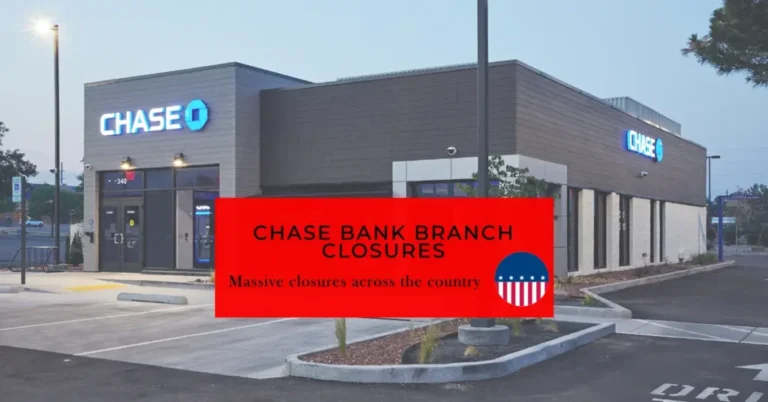In today’s digital age, the way we bank is rapidly changing. Technology has revolutionized the banking industry, pushing more services online and reducing the need for physical branches. This shift has left many wondering, “Is Chase Bank closing?” This blog post will explore the reasons behind Chase Bank’s branch closures, the impact on employees, and the future of banking.
Overview of Chase Bank
Chase Bank is a leading financial institution in the United States, serving millions of customers. With a robust portfolio of services, ranging from personal banking to investment banking, Chase Bank has a strong presence across the country. However, recent announcements regarding the closure of select branches have left customers and employees alike with questions about the bank’s future.
Is Chase Bank Closing?
To answer the burning question, “Is Chase Bank closing?” – the answer is both yes and no. Chase Bank has announced plans to close branches across nine states in the U.S in 2024. While this might sound alarming, it’s crucial to understand that this is part of a larger shift within the banking industry. The rise of online banking has influenced this decision, as more customers opt for digital banking, reducing the necessity for physical branches.
Chase Bank Closure?
Despite the closures, Chase Bank plans to open 400 new branches in 25 states. This move aligns with their strategy of investing more resources into upgrading its digital platforms while maintaining a physical presence where necessary. Over the past five years, the bank has closed 650 branches, a trend that is expected to continue as online banking becomes the norm.
Impact Of Chase Bank Closure On Employees:
The closures undoubtedly impact the bank’s employees, leading to job losses. However, with the bank’s push towards digital, new opportunities in tech-related roles within the bank are emerging. Chase Bank will need skilled personnel to manage and upgrade its online platforms, creating new job prospects.
Why Are Chase Banks Closing Branches?
In recent years, we have witnessed a surge in Chase Bank closing various branches across the United States. This phenomenon has left many customers wondering what could be the reasons behind these closures. In this blog post, we will explore some of the primary factors contributing to Chase Bank’s decision to close branches and how this may impact the banking landscape.
– Evolving Customer Preferences: One of the main reasons behind Chase Bank closing branches is the shift in customer preferences. With advancements in technology, more and more people now prefer online banking, reducing the need for physical branches. As a result, Chase Bank has been focusing on enhancing its digital platforms to cater to the changing demands of its customers.
– Cost Efficiency: Running a physical branch can be expensive, with costs such as rent, utilities, and employee salaries. By closing underperforming or redundant branches, Chase Bank can save on these expenses and allocate resources to improve other areas of its business, such as digital banking services.
– Consolidation: Another factor contributing to Chase Bank closing branches is the consolidation of its operations. By merging smaller, less efficient branches with larger, more profitable ones, the bank can streamline its operations and improve overall efficiency.
– Increased Competition: The rise of digital banks and fintech companies has led to increased competition in the banking industry. As a result, traditional banks like Chase must adapt their strategies to stay competitive. This includes closing branches that are not contributing to their overall growth and profitability.
– Regulatory Changes: Changes in banking regulations may also play a role in Chase Bank closing branches. For instance, new regulations might require banks to maintain higher capital reserves, prompting them to cut costs by closing branches.
List of Chase Bank Branches In The USA
- New York City, NY
- Los Angeles, CA
- Chicago, IL
- Houston, TX
- Phoenix, AZ
- Philadelphia, PA
- San Antonio, TX
- San Diego, CA
- Dallas, TX
- San Jose, CA
- Austin, TX
- Jacksonville, FL
- Fort Worth, TX
- Columbus, OH
- San Francisco, CA
- Charlotte, NC
- Indianapolis, IN
- Seattle, WA
- Denver, CO
- Washington, DC
Please note that this list is not exhaustive and only includes some of the major cities where Chase Bank branches are located. For a complete list of branches and their specific addresses, you can visit the Chase Bank website or use their branch locator tool.
Conclusion:
In conclusion, the question, “Is Chase Bank closing?” can be answered as a partial yes. Yes, there are branch closures, but these are part of a broader trend towards online banking. The bank is not closing entirely; instead, it is evolving, adapting to the digital world and the changing needs of its customers. While this transition presents challenges, especially for those less comfortable with digital banking, it is a necessary step towards a more technologically advanced banking landscape.
Chase Bank’s decision to close branches is primarily driven by the need to adapt to the changing banking landscape and improve overall efficiency. While this may be inconvenient for some customers who rely on physical branches for their banking needs, it is an essential step for the bank to remain competitive in the digital age.
You may also like:

